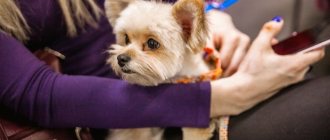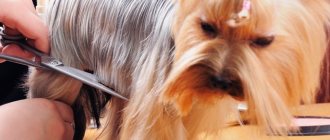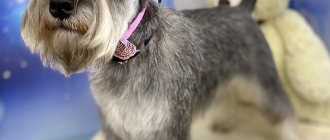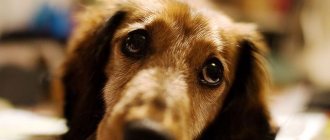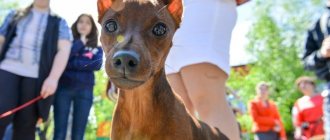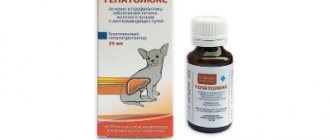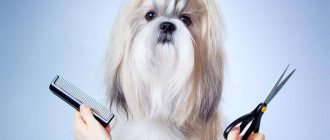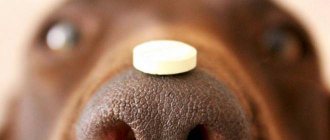The rules for keeping dogs at home include not only a healthy, nutritious diet and regular walks in the fresh air, but also a whole range of mandatory procedures for caring for the animal. To maintain hygiene and cleanliness of the coat, grooming is recommended.
In the article we will tell you what grooming is and what breeds of dogs need it, types of grooming, features of the procedure, where it is better to groom your pet - in a salon or at home, what tools and means are needed.
Grooming: what is it?
Grooming is a necessary and important part of caring for a pet. It improves the quality of his life, allows him to remain healthy and makes the life of his owners more comfortable. It's not just about grooming. The set of procedures includes treatment of the pet’s eyes, ears, claws and teeth. Therefore, everyone needs them, even smooth-haired dogs.
Why is it carried out?
Every dog needs care. Regular grooming will help avoid many problems:
- inflammation of the ears or eyes;
- blockage of the anal glands;
- formation of tangles on wool;
- the occurrence of dermatitis, fungus or inflammation on the skin;
- reproduction of parasites;
- damage to teeth;
- ingrown claws
What breeds are required?
Basic hygiene routines, including bathing, cleaning ears, eyes, teeth, and trimming nails, are necessary for all dogs. But there are several breeds that also need professional grooming. Usually it is carried out before exhibitions, making special haircuts that emphasize breed characteristics.
Wire-haired breeds require special grooming. They are trimmed to remove dead hairs, since the fur does not shed on its own. Many long-haired breeds get special haircuts. These are Yorkshire terriers, Chihuahuas, spaniels, poodles, retrievers, and chow-chows.
There are several breeds with a special type of coat - husky, collie, spitz, German shepherd, malamute, maltese. Their undercoat consists of guard hairs. Grooming is not recommended for these breeds. It disrupts the structure of the coat, slows down its growth, and deprives the skin of protection. The dog may even go bald after a haircut. But they need to be brushed regularly.
When to accustom your pet to grooming?
It is necessary to accustom your pet to grooming from an early age. All hygiene procedures must be carried out regularly. Then the adult dog will calmly accept trimming his nails and brushing his teeth. It is important to train long-haired dogs to brush. The main thing is that the pet does not experience any unpleasant sensations.
What breeds need a haircut
Almost all long-haired breeds require regular grooming. Even if for a dog, as a representative of a show breed, its “hair” is a real advantage, before the corresponding event the pet must undergo the mentioned procedure. The “head” receives the necessary volume and takes on a shape that only emphasizes the advantages of its appearance. However, even if the pet does not participate in competitions, any decorative breed (for example, Yorkshire terrier, poodle, spaniel) needs a haircut for the above reasons.
There are breeds that do not need to be subjected to the procedure or are not allowed to be cut at all:
- Short-haired breeds. For them, regular brushing will be sufficient, which is especially necessary during the molting period.
- Wire-haired breeds (e.g. Schnauzer, Airedale). Grooming (haircut) in their case is unacceptable, as this can spoil the quality of the coat. However, for such dogs, trimming is used once every few months (plucking off regrown hair on the surface of the body and head). Scissors may only be needed to shape individual parts of the body.
- Some are long-haired. Grooming is not necessary for them, since due to the special structure of the wool, tangles do not form. These include: collies, chow-chows, huskies, huskies, Australian, Belgian shepherds.
This is interesting! Trimming large breeds with short, dense hair or thick undercoat is a real stress for the animal. The coat of such dogs takes a very long time to recover, and there is no guarantee that its former beauty will return.
What is included in comprehensive care?
Comprehensive pet care includes the following procedures:
- cleansing the ears of dust, dirt and wax;
- washing the eyes, removing secretions and traces of tear tracks using special solutions;
- trimming and sharpening of claws, coating with protective agents;
- bathing with special shampoos using balms, conditioners as necessary, drying;
- combing wool, untangling tangles, removing debris and dead hairs;
- doing hairstyles or haircuts;
- cleaning the anal glands;
- treatment for external parasites;
- brushing teeth with veterinary paste.
How often?
The frequency of hygiene and aesthetic procedures depends on the breed. It is usually recommended to clean your eyes and ears 1-2 times a week. But some dogs need it more often. If the ears are long and droopy, there is a greater risk of developing inflammation. Brachycephalic breeds with bulging eyes need to be washed daily. Claws are trimmed as they grow. If your pet walks on the asphalt a lot, they wear down on their own and may only require filing.
Bathing most breeds is not recommended often - usually 2-4 times a year is sufficient. But show dogs are washed every month or even more often. Representatives of long-haired breeds will need brushing several times a week. And during molting - every day. For smooth-haired dogs, it is enough to go through the fur once a week with a brush or rubber mitt.
Description and features
In addition to haircuts, dog grooming includes the following procedures:
- cleaning or rinsing the ears;
- trimming claws, sharpening them and covering them with protective and decorative means, if desired;
- washing the eyes with antiseptic agents;
- clearing the sinuses;
- washing with disinfectants and drying;
- preventive treatment against the possibility of infection by parasites, ampoules are usually used on the withers;
- cleansing the anal glands;
- detangling wool if necessary;
- teeth cleaning.
That is, the main feature and main difference of this procedure is that, once on the grooming table , the dog will receive a full range of care, in other words, grooming salons are similar to beauty salons and differ from a simple haircut procedure in the same way as a beauty salon from a hairdresser's .
In addition to the above procedures, which are always included in grooming, each salon also offers something else, for example, the use of dog grooming spray , which allows you to “maintain” the volume and shape of the animal’s “hairstyle” for a long time, by securing the roots of the guard hair in a certain position
Types of dog grooming
If the owner decides to groom his pet on his own, he needs to know what types there are.
- Hygienic or routine procedures required for all dogs. This is care for ears, eyes, teeth, claws. Sometimes trimming the hair between the toes, on the muzzle, under the tail. It is carried out as necessary from 1 to 4 times a month.
- Exhibition grooming is carried out by professionals. Most owners have no idea how to properly prepare a dog for an exhibition in order to show all its advantages and hide its shortcomings. Groomers know the characteristics of different breeds and exhibition requirements for them.
- Creative grooming is done for decorative pets. These are different hairstyles or haircuts, often unusual. You can create patterns from wool, textured transitions, and dye it in different colors.
Types of haircuts
A hygienic haircut is done for any long-haired dog. It is necessary in hot weather, before surgical interventions, and in the presence of a large number of tangles. With such a haircut it is easier to keep the animal clean. It’s easy to do: shorten the hair on the face, under the tail, between the toes.
But for many breeds, special types of haircuts are used for grooming.
- Trimming or stripping is plucking out dead hairs. Suitable for wire-haired breeds: terriers, schnauzers. It is performed using a special knife or with your fingers (placking).
- Rolling is one of the types of trimming. Used for wire-haired breeds before shows. The technique is complex, designed to create the most natural, but well-groomed condition of the coat.
- Klipwerk is a very short haircut using a clipper, often almost bald. May be uniform or with transitions to longer coat lengths. Most often used for poodles.
- Blending or thinning - smooth transitions from short to long hair. Suitable for Yorkshire Terriers, Cocker Spaniels. This is done using special scissors or a machine.
- Top note is not a haircut, but a hairstyle. Suitable for pets with long hair on their heads, as well as for dogs with bulging eyes. They need to collect their hair in ponytails, braids using elastic bands, and hairpins.
How to cut cats
Most cat owners want their pet to have a healthy, fluffy coat, no matter what breed the animal is. However, due to the fact that the animal has many contact zones, tangles can form, and the fur often sheds. That is why, in order to maintain fluffy wool, masters use hygienic haircuts. The excess six is removed from the animal’s groin area, as well as from the inner thighs.
Grooming for cats is very similar to grooming for dogs: the animal is washed, its ears are cleaned, the hair is dried and pulled out with a hairdryer. The animal’s claws are also trimmed and dental care is provided.
Thanks to such procedures, muscles work better and blood flows to the organs. In addition, when a cat licks itself, fewer hairs enter its stomach. You may also notice a decrease in hair on furniture and clothing. Also, sometimes a haircut is carried out because a person has an allergic reaction, or the animal has severe injuries. If you can see open sores on your cat, your veterinarian will recommend shaving the area.
Stages of implementation
Not all procedures are always followed during grooming. Their choice depends on the breed, age, health and individual characteristics of the animal. But there are a few basic steps that are necessary for all dogs.
- First, the fur is thoroughly combed. It is necessary to remove not only dead hairs, but also debris and tangles.
- Then the haircut is done. It can be hygienic or special.
- Treating ears, eyes, teeth and trimming nails.
- For small dog breeds, cleaning the anal glands is necessary.
- Then the animal is bathed. A special shampoo is used.
- The last stage is drying and combing the wool. Long-haired breeds can be styled or have different hairstyles.
Who is it suitable for?
A representative of this profession must love animals - this is a prerequisite. If a groomer is indifferent to animals, both pets and their owners will feel it, then he will not have clients. A number of other qualities are also important:
- patience and stress resistance;
- positive attitude;
- the ability to find a common language not only with cats and dogs, but also with their owners;
- accuracy and pedantry;
- desire to constantly improve your skills.
Like all professions, this one has its pros and cons. The positive points include:
- communication with animals;
- speed of mastering the profession;
- decent income if you have skill;
- the opportunity to open your own business without much investment;
- flexible work schedule.
The disadvantages of the job are the possibility of getting infected from an animal (but this happens infrequently) or being bitten by it, scandalous clients, the difficulty of studying different species and breeds of animals. However, all these disadvantages are more than offset by the advantages.
Where is it better to do it: in a salon or at home?
A specialist in professional animal care is called a groomer. A visit to the salon is worth it for those owners who, for some reason, cannot care for their pet or do not know how to properly carry out hygiene procedures. There are salons in all major cities. They are equipped with special devices and tools. They use professional tools and tools.
But many owners prefer to groom their dog themselves. This allows you to save money and time, and perform the necessary procedures when it is convenient. In addition, the dog will feel more relaxed in familiar conditions. And many animals do not trust strangers. With home grooming, you can avoid unnecessary stress for your dog and make the procedure more comfortable.
Required Tools
To care for your pet yourself, you need to purchase special tools and equipment. Their choice depends on the breed and size of the dog. To avoid buying something unnecessary, it is better to consult a breeder or professional groomer.
- You will need a table so you don't have to bend over. It is better to use a special one, with a rubberized or corrugated surface. They are foldable and have a drain.
- A special crescent-shaped or guillotine nail clipper. The size is selected depending on the breed. To prevent the nails from peeling, it is also recommended to use a nail file. Filing can replace nail trimming if the owner has no experience and is afraid of touching a blood vessel.
- For combing, several types of combs are needed, with long and short teeth, frequent and sparse. Brushes with natural bristles, metal or plastic. You will also need a silicone mitt, which is good at removing lost hair from smooth-haired dogs and at the same time giving a massage.
- Special tools: furminator, slicker, tangle cutter - for long-haired dogs. Wirehaired cats require different trimming knives.
- Special cosmetics: shampoos, bathing balms. They need to be selected according to age, coat type and color. Long-haired dogs will also need conditioners and oils to make combing easier. Special products are also needed to care for your eyes, ears and teeth.
- To cut long-haired dogs, you will need several types of scissors. These are ordinary straight ones, thinning ones, with curved ends, small rounded ones.
- A machine may be required. A special one is needed, since human hair is not suitable for wool. It is convenient to use different ones: manual and electric.
- It is also recommended to purchase more cotton pads, cotton swabs, and napkins in advance. Your pet needs separate towels.
At what age can you cut a dog's hair?
to accustom your animal to dog grooming tools and to the grooming procedures themselves from a very early age. After all, if an animal has never had its claws trimmed, its ears cleaned, or its fur combed, it will not behave calmly when the owner decides to start the grooming process, and certainly will not allow a stranger to do these manipulations.
Moreover, the groomer may simply refuse to work with an animal that is not accustomed to hygiene procedures. That is, you need to wash the eyes, clean the ears and nose, comb the animal and file its claws from the age of one month, and this must be done regularly.
It is recommended to start the actual cutting process at 4-6 months, but this is individual and depends on the animal’s personal data - the rate of hair growth and its thickness. You can give it a light shape using scissors from an earlier age.
Advice from professionals
Learning how to properly care for a pet is not difficult. Advice and recommendations from professionals will help you avoid mistakes.
- Do not use tools or cosmetics intended for human use. Animal fur has a special structure; the skin is usually more sensitive.
- Large dogs, as well as highly aggressive or restless animals, must be calmed before grooming. Medications may be used. And during the procedures it is advisable to immobilize them.
- It is better to use microfiber towels for drying. They absorb moisture well. It is not advisable to dry long-haired pets with a towel - the fur may become tangled. It is better to dry them with a hairdryer while combing them.
- It is advisable to use balms and conditioners when grooming. They protect against dry skin and tangling, and the coat does not get dirty longer.
- Instead of brushing your teeth, you can give your pet special chewy treats or bones from veins.
Grooming is a comprehensive dog care that includes hygiene procedures and improvement of appearance. It can be carried out both in the salon and at home. A well-groomed animal looks attractive and feels better.
Washing and drying pets
Washing is an important procedure for every animal. The specialists of the Mater Groom salon give some recommendations:
- During water procedures, the pet's head should be tilted back to avoid water getting into the ears.
- It is not recommended to use shampoo in its pure form; it must be diluted with water and shaken until foam forms.
- Dogs living in the city can be washed once every 14 days.
- A hairdryer is used during drying, because... the towel may harm the fur.
- The head is dried last, during which styling is done.
The salon's specialists know how to give your pet a stylish appearance. They are familiar with the basic rules and will do everything to make the pet look perfect.
Salon or home conditions?
Pets require care, all owners know this. However, many believe that the procedures can be carried out at home, without resorting to the services of professional groomers. This approach is quite justified if the owner of the dog or cat has the necessary skills. Often, inept actions towards animals lead to conflicts that arise between owners and pets. The advantages of hiring a professional groomer in a salon are well known:
- masters know how to find an approach to animals, accustom them to periodic hygienic procedures;
- the groomer’s arsenal includes professional tools and medicinal products from well-known brands;
- The salon specialist selects individual procedures for each pet, the choice is based on the characteristics of the breed, physiology and character of the animal.
A professional approach to grooming ensures proper hygiene, a well-groomed appearance and a cheerful mood for the animal.
Who doesn't need a haircut?
Grooming refers to a set of procedures that maintain the health of dogs and cats. Grooming is one of the components of grooming, however, it is not recommended for all animals. A professional groomer will not cut a dog that has a special coat structure consisting of undercoat and guard type hair. Grooming disrupts the physiology of the animal. This type of coat retains air, which keeps the animal warm.
Experts do not recommend cutting cats unless absolutely necessary. Animals need a haircut for medical reasons, in hot weather, or for diagnostic procedures. The desire to give a cat a fashionable hairstyle can lead to stress and loss of appetite in pets.
Adviсe
If you want your pet to be healthy and have an attractive appearance, the groomers at Mater Groom recommend:
- Pet care. This will keep the animal's coat in good condition.
- Brush daily to avoid tangles.
- Wash 2 times every 30 days. This rule must be followed especially during the rainy and muddy season.
- Haircut in summer is required. The master will remove long hair, giving the pet lightness and comfort.
If you want your pet to always look beautiful, update its haircut once every two months, and the groomers of the Mater Groom salon will help with this.
Precautionary measures
When grooming a pet, it is not recommended to trim the fur to zero. It is better to entrust such a haircut to a professional hairdresser, since if you handle the tools carelessly, there is a high risk of causing damage to your pet.
Photo 3. Chic Maltese hairstyle
Particular care should be taken when grooming dogs that are rarely subjected to this procedure. Animals that are not accustomed to “incomprehensible” manipulations tend to express anxiety, and it is difficult to keep them in one place.
Excessive activity of the pet dog during the grooming process often leads to microtrauma. To prevent them, you should calm the animal, pet it more often and communicate with it, distracting it from the groomer’s body movements.
If the animal's skin is damaged, the wound should be immediately treated with hydrogen peroxide or another antiseptic. Even before you start cutting, you should make sure that you have the appropriate medications so that they are at hand at the right time.
If the animal's eyes or mucous membranes are damaged, you should immediately contact the nearest veterinary clinic, since such injuries are fraught with complications.
Business risks
The main risk is associated with incorrect assessment of demand and competitors. Also, the entrepreneur must justify the feasibility of spending on equipment, without losing the quality of services.
Grooming is a promising business for large cities, where many people keep pets and are willing to spend money on them. But it is important to soberly assess the demand and competition in your area before you decide to open your own grooming salon.
Professional dog grooming techniques
The technique of cutting dogs also depends on the purpose of the haircut: to prepare the animal for participation in exhibition events, for everyday care, due to the presence of skin diseases in animals that require special treatment, and so on.
Some of the most common dog grooming techniques include:
- flatvec (leveling haircut, ensuring the same length of coat in all areas);
- clippervek (short clipper haircut);
- showtrim (comprehensive professional grooming of animals for participation in exhibitions and competitions);
- blending (haircut using thinning scissors; used at the final stage to smooth out differences in the length of the hairs);
- topnot (use of additional accessories and devices - bows, hairpins, elastic bands, combs, etc.).
